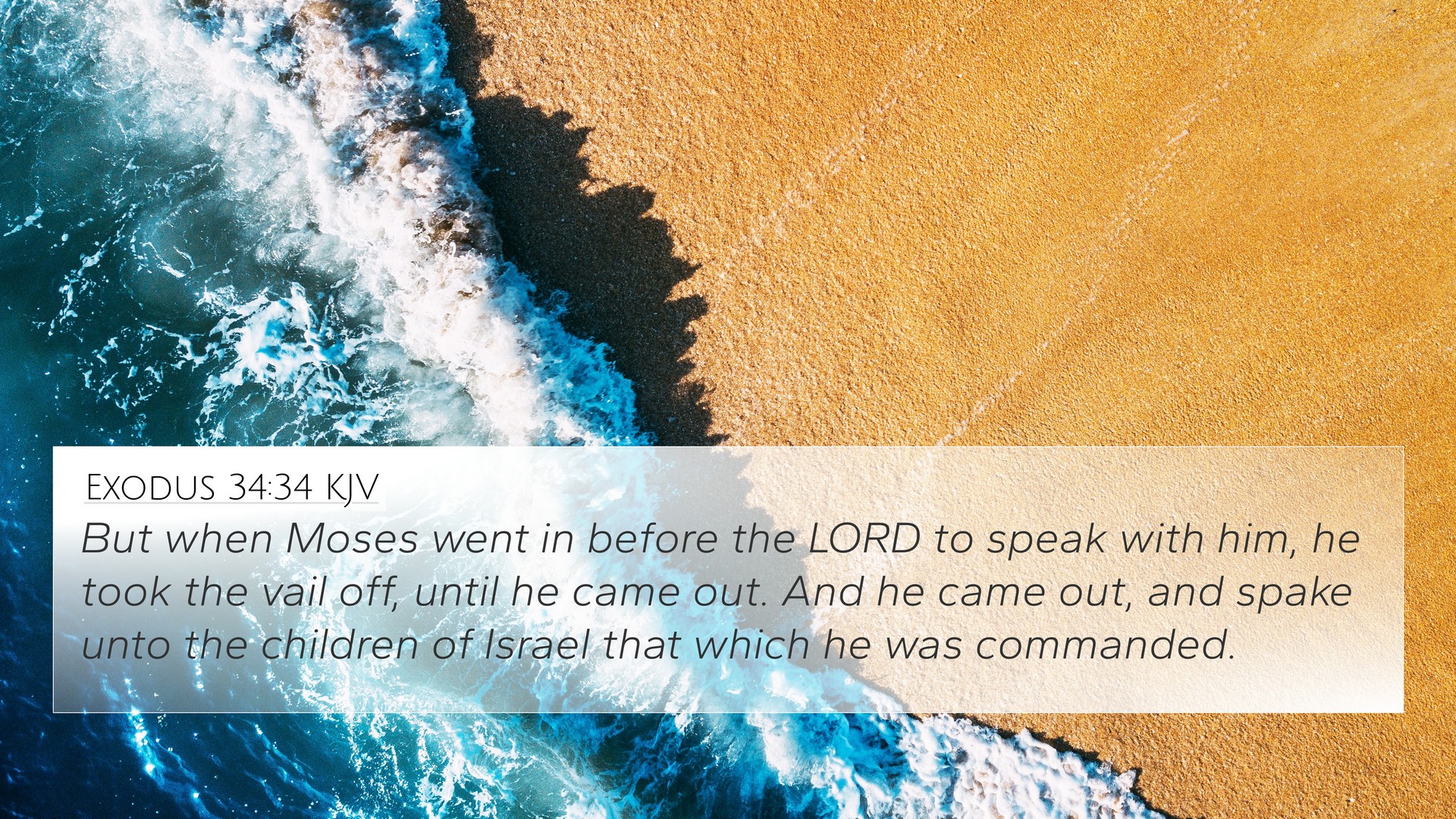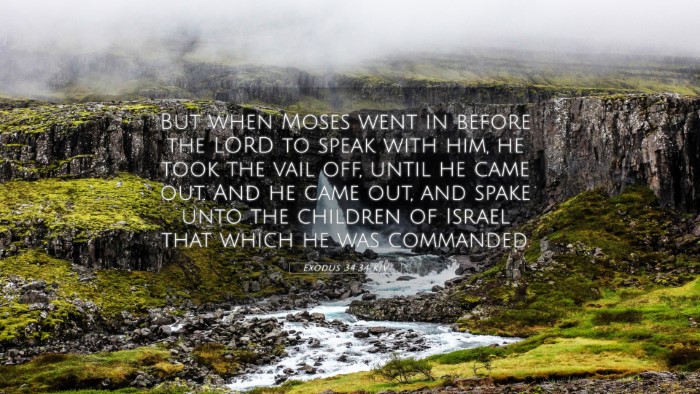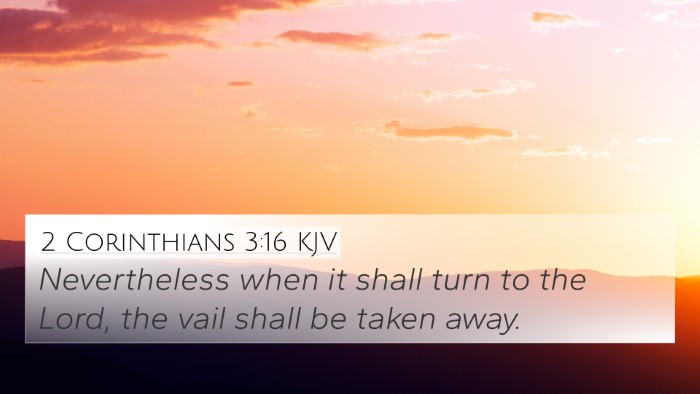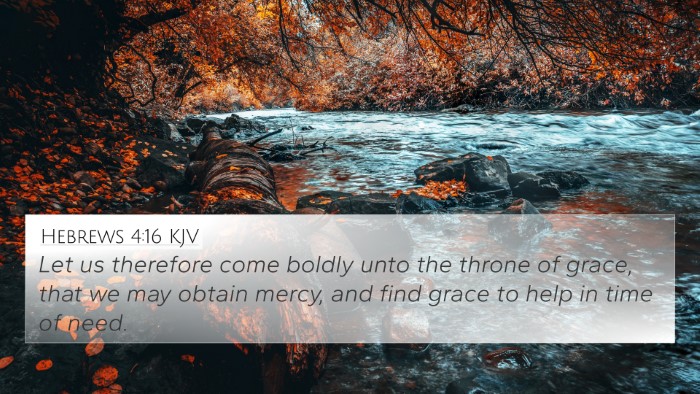Understanding Exodus 34:34
Exodus 34:34 states, “But whenever Moses went in before the Lord to speak with Him, he would take the veil off until he came out. And when he came out and told the children of Israel what he had been commanded,” This passage signifies profound spiritual truths about communication with God and the reflection of divine glory.
Meaning and Context
This verse occurs after Moses received the tablets of the Law a second time, following the Israelites' idol worship. It highlights Moses' unique role as a mediator between God and Israel.
Insights from Commentaries
- Matthew Henry: He indicates that the act of Moses removing the veil symbolizes the openness of communication with God. The veil represents separation due to sin; however, in Moses’ case, his access to God shows a restored relationship.
- Albert Barnes: He emphasizes the significance of Moses “coming out” to communicate God’s commands. The radiant countenance of Moses illustrates the changes that occur when one encounters the divine presence.
- Adam Clarke: Clarke elaborates on the metaphor of veils used in worship, suggesting that Moses’ removal of the veil signifies truth and transparency in communion with God that contrasts with the spiritual blindness of the Israelites.
Thematic Connections
Exodus 34:34 can be linked with various themes throughout Scripture. Below are some thematic Bible verse connections that enhance our understanding:
- 2 Corinthians 3:13-15: Discusses the veil over the hearts of the Israelites when reading the old covenant; revealing the contrast with the glory seen in Christ.
- Hebrews 9:7: Describes the layers of separation between God and man in the old covenant, enhancing appreciation for Christ’s sacrifice.
- 1 John 1:5: Declares that God is light, and in Him is no darkness at all, reinforcing the idea of revealing God without a veil.
- Matthew 17:2: The transfiguration of Jesus, where His face shone like the sun, is a parallel to Moses' face shining after encountering God.
- John 1:14: The Word becoming flesh reflects the glory of God among us, suggesting that just as Moses reflected God’s presence, we can reflect the glory of Christ.
- Romans 8:9: A reminder that believers possess the Spirit of God, connecting us directly to God without veils, promoting acknowledgment of our access to Him.
- Revelation 22:4: Envisions a future without barriers, where God's servants will see His face, fulfilling the ultimate promise of unmediated access to God.
Summary and Conclusion
The study of Exodus 34:34 through the lenses of Matthew Henry, Albert Barnes, and Adam Clarke reveals a tapestry of ideas surrounding divine communication, spiritual transformation, and the fulfillment of God's promises. Moses’ example illustrates the power of direct communion with God, inviting believers to reflect His glory in their own lives.
Tools for Cross-Referencing
To better understand and connect biblical texts, consider employing these tools for Bible cross-referencing:
- Bible Concordance: A resource that indexes words and phrases within the Bible to help locate verses on similar subjects.
- Bible Cross-Reference Guide: Provides links between similar themes and concepts throughout the Scriptures.
- Cohesive Bible Study Methods: Gathers comparative insights from Old and New Testament scriptures for deeper understanding.
Inter-Biblical Dialogue
The connections made within Exodus 34:34 and its parallels encourage a practice of cross-referencing biblical texts that illuminate the overarching narrative of Scripture. When engaging in comparative studies, one might explore:
- How Jesus’ ministry reflects the principles established in the Law delivered by Moses.
- Interactions between prophetic writings and the teachings of the Apostles, enriching our understanding of God’s intentions.
- A review of Psalms’ prayerful reflections against theological themes in the New Testament.
Further Study
For those interested in detailed studies, consider how to identify connections between individual Bible verses, explore themes that bridge the divide between the Old and New Testaments, and understand the implications of God's enduring presence through biblical history.
Related Verses for Further Reflection
When exploring Exodus 34:34, you may consider its connections to:
- Isaiah 60:1-3 - Arising to shine, as God's glory is given to His people.
- Galatians 5:22-23 - The character of the Spirit-filled life reflecting God's nature.
- Psalm 34:5 - Those who look to the Lord are radiant and will not be ashamed.
- James 1:17 - Describes God as the Father of lights, emphasizing purity and illumination.
In conclusion, the study of Exodus 34:34 not only reflects a moment in Israel’s history but transcends time, pointing to the ways in which God desires to interact with His people today, encouraging believers to embrace the light and truth that comes from direct communion with Him.





